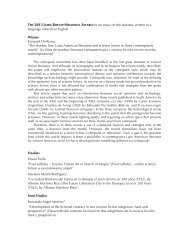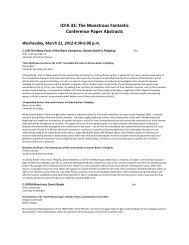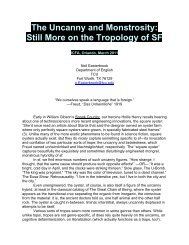<strong>Monstrous</strong> Controls: <strong>The</strong> Illusion of Control in Survival Horror Video GamesEdward HowarthLongwood UniversityClive Barker notes that “[Horror] shows us that the control we believe we have is purely illusory, and that every moment we teeter on chaosand oblivion.” In horror literature and film, it is this instability of control that lends itself to the fear we feel when, as mere observers, we lookon helplessly at the characters fumbling through the dark. However, though this lack of control is true of literature and film, video games -where the observer becomes participant, the reader becomes player- prove the exception. Physically guiding characters through murkyswamps, mouldering corridors, demonic classrooms, the control given to us in survival horror games is far from illusionary. Instead, we aregranted direct control over the characters, control that allows us to succesfully combat the various fiends and horrors dealt to us throughoutthe game’s narrative. However, if fear is generated through a loss of control, a question is raised regarding how a horror video game can createfear if the player is constantly in control. This proposed essay will explore how survival horror video games use controls to make us feel out ofcontrol, pursuing the idea that, though we may seem to have control, we are never truly in control.96. (H/FTV) Dirty Little Secrets DogwoodChair: Beth FeaganLongwood UniversitySexing the Vampire in Gothic Literature: How Repressed Sexuality Shaped a Modern MonsterAngela StillUniversity of Southern MaineIn the wake of the Industrial Revolution, British society was restructured along unbendable gender lines. Overt repression of women andhomosexuals not only intensified, but became the social norm, and was, in some cases, enforceable by law. Gender roles were strictlyredefined, resulting in an idealized definition of family and family life. This definition was so confining, anyone who did not adhere to it becamea social outcast. This environment spawned Gothic literature, a popular form of fiction that allowed the “other” to express its fears andfrustrations in a safe but public forum through the use of highly stylized settings, family plots, and monstrous beings. Gothic fiction’s extremepopularity faded somewhat in the mid-twentieth century, though it never completely died out. In the late 1960s and early 1970s, however, thegenre enjoyed a revival in America, where many of the same issues that originally gave birth to Gothic had resurfaced. In 1976, Anne Ricepublished Interview with the Vampire, and the Gothic novel once again reflected society’s anxiety about gender roles and their definitions. <strong>The</strong>success of Rice’s debut injected both the Gothic genre and the vampire myth with new life, providing the catalyst that would pave the way forthe vampire to become the sociosexual phenomenon it is today – a preternatural creature who embraces a future without the limitations ofgender – and for Gothic literature to regain its place at the forefront of popular fiction.Female Abominations: Undermining Male Hegemony in H. Rider Haggard’s SheGareth Hadyk-DeLodderUniversity of FloridaNineteenth-century monstrosity comes, fittingly enough, in many shapes and sizes. It is not surprising, then, that a historical period whichwitnessed a meteoric rise in evolutionary thought, degeneration theory, and psychological inquiry would have given birth to or popularizedsome of the archetypal monsters that we recognize and embrace today: the vampire, the doubled man (Jekyll and Hyde), Frankenstein’soriginal monster, and many more. <strong>The</strong>re is a wealth of critical readings concerning each, which help us to map out many of the ways in whichwe can view the “monster” as an essential part of a nineteenth-century or a Victorian zeitgeist. Fewer readings are available, however, of somelesser known but equally “horrifying” characters, including, as I will argue here, a radically “Other” priestess figure who was prominent in someof the fictions of H. Rider Haggard and Marie Corelli. Over the course of this presentation, I will explore how the trope of the foreign priestess,whether located in a fantastical, alternative geography (Haggard) or a fictional history (Corelli), destabilized and, in some cases, violentlysubverted many established Victorian epistemologies. Specifically, I would like to outline some of the ways that Haggard’s She (1886-1887) andCorelli’s Ardath (1889) position their respective priestess figures—the iconic Ayesha in Haggard’s text and Lysia in Corelli’s—as a counterpointto orthodox narratives of female ontology and agency. Published within two years of each other, both novels were extraordinarily popular,outselling many of their more respected (and now considered canonical) contemporaries. <strong>The</strong> two novels, then, are uniquely situated to helpframe some of my questions concerning the nature of male horror after their encounters with the two women, and how Ayesha and Lysiaembody Victorian anxieties about science, religion, and gender.Weaponizing Seduction: Exploring Sexual Violence in Ghost FictionManuel TejedaBarry UniversityNoelle BowlesKent State – TrumbullGhosts are at once the most ubiquitous undead as well as the most distant and secretive of their kin. <strong>The</strong>y are culturally universal and as onceliving humans, are psychologically familiar to us. We can sympathize with their motives and circumstances at their death to rationalize theircurrent activities and existence despite their poor methods of communication, through psychic mediums or weird electronic devices of dubiouseffect. Yet that familiarity extends only to the psychological as the physical experience is only available to ghosts as memory and to us only asimagination. As once living beings, we presume all undead types share the former sexuality of the living from which they were created. Yetthat sexuality, particular the seductive elements of the sexual experience are overlooked in the fiction of ghosts. <strong>The</strong> corporeal undead havevery clear reasons for corporeal seductive engagement with the living: vampires/blood. While other undead employ seduction for some form
of cannibalism, ghostly seduction is almost exclusively sexually violent. <strong>The</strong> seductive engagement of ghosts and the sexual violenceaccompanying that engagement are the central points of exploration of this proposal.97. (CYA) Reflecting Reality: YA Dystopias and <strong>The</strong>ir Real World Contexts Captiva AChair: Alaine MartausUniversity of Illinois, Urbana-Champaign<strong>The</strong> Monstrosity of Humans in <strong>The</strong> Hunger Games: How We Got <strong>The</strong>re and Why We're So EnthralledAndrew SeegerConcordia University WisconsinImagine a game of Tribond where you had to uncover the common bond between reality television, the Iraq War, and the Greek myth of<strong>The</strong>seus. What would you come up with? Author Suzanne Collins came up with <strong>The</strong> Hunger Games, a post-apocalyptic YA science-fiction trilogy.With this knowledge, one can certainly make connections not only with current reality TV shows like Survivor, Amazing Race, and <strong>The</strong>Bachelor/<strong>The</strong> Bachelorette, but also with stories like Shirley Jackson’s “<strong>The</strong> Lottery” and Stephen King’s novels <strong>The</strong> Long Road and <strong>The</strong> RunningMan. Other lesser-known works also share characteristics with the trilogy, including early reality show American Gladiators, Australian filmTurkey Shoot (Escape 2000) and Japanese films Battle Royale and Series 7: <strong>The</strong> Contenders. <strong>The</strong> Hunger Games reflects not only connectionswith literature and other media, but also with society’s real-life fascination with violence, all-too-real historic events, current protests anduprisings against authoritarian powers, and dystopian visions of the future. In this paper I would like to explore the different ways in whichthese novels capture the Zeitgeist and our addiction to violence that goes at least as far back as the Roman Colosseum.<strong>The</strong> Hunger Games as Social Commentary: Monsters R UsScott D. Vander PloegMadisonville Community College<strong>The</strong> Hunger Games concept is being regularly referenced in relation to dystopian societies. Reviewers and critics are commonly caught up inmeasuring the degree to which Collins is presenting us with the new Handmaiden’s Tale, or 1984. While that is a reasonably true perception, itis also a distraction from the main lines of development that Collins is working from, the scaricty-strife story. Instead of focusing onutopic/dystopic tropes, a Marxist-reading of Hunger Games reveals a strategy that is two-pronged: a condemnation of totalitarianism and anunderdog advocacy to build reader sympathy for the protagonists—who are emphatically class tagged. It seems clear in the first of the trilogythat Collins is more focused on establishing characters we care about, and jogging our sympathies by providing them with humble backgrounds,almost Dickensian—“please, sir, may I have some more…”. <strong>The</strong> dystopic Panem government is a faceless monstrosity, no doubt, but thenarrative is less focused on emphasizing this than it is in giving us the characters of Katniss and Peeta.We the Monsters: Feeding the System and Devouring Ourselves in M.T. Anderson’s FeedBrandi J. VenableRutgers University-CamdenThis presentation will focus on the young adult novel Feed (2002), written by M. T. Anderson. In his novel, Anderson presents a futuristicconsumer-driven culture controlled by corporations. Humans are implanted with “feeds” at an early age, which stream the latest trends andsway purchasing decisions. Natural resources are depleted or polluted, and environments are mere artificial creations. <strong>The</strong> plot follows thenarrator Titus and his relationship with Violet, a girl who resists the feed. Anderson shows what happens to their relationship when Violet’sfeed ultimately malfunctions, endangering her life. In Feed, Anderson illustrates how the natural world, privacy, relationships, free will, andlanguage are all susceptible to decay and destruction in a culture with a monstrous appetite for material goods. Although the book is gearedtowards a teenage audience, it is pertinent to more than one generation of consumers. <strong>The</strong> book serves as a fictional platform that encouragesdialogue about the horrifying possibilities of capitalism, corporations, and technology if left unchecked. Approaching the text from a Marxistperspective, I will argue that the monsters of today are more ambiguous than the monsters of the past, and are often disguised behind humanvisages. In this dystopian novel, fetishizing material culture comes at the price of objectifying each other and eroding human relationships.Perhaps the most adept function of Anderson’s work is to demonstrate the dualistic nature of media and consumption. It is at onceinhumane—breeding corruption and greed—and also incredibly seductive and alluring (a dichotomy which is present in other monstrousbeings). It is the latter characteristics that drive us to continuously feed the system. By doing so, we become our own monsters, consumed byan insatiable desire for material objects to such an extreme that we devour our humanity in the process of acquisition.





